During our round trip through Andalusia in Spain, we stopped in Seville. Seville is located in the south of the country and is about 1.5 hours from Cadiz. Here, you can expect streets decorated with orange trees, beautiful palaces, fiery flamenco dancers, charming streets and alleys in the old town, cool shops, cozy cafés, and much, much more. We particularly enjoyed the Spanish serenity, the flair, and the diverse sights. Today, we’ll show you which sights in Seville await you and what you shouldn’t miss. By the way, you can also find our top highlights in Andalusia here.
- Seville sights
- 1. Plaza de España
- 2. Metropol Parasol
- 3. Seville Cathedral
- 4. Alcazar Seville
- 5. Break in Maria Luisa Park
- 6. The Bullring
- 7. The old town of Seville
- 8. The Santa Cruz District
- 9. On the Rio Guadalquivir
- 10. The original Triana
- 11. The Torre del Ora
- 12. Archivo General de Indias
- 13. The city palace Casa de Pilatos
- 14. Plaza del Cabildo
- 15. Amillo Park in Seville
- The best tours & excursions
- Getting to Seville
- Best time to visit Seville
- Booking accommodations
- Travel reading for Seville
Seville Sights
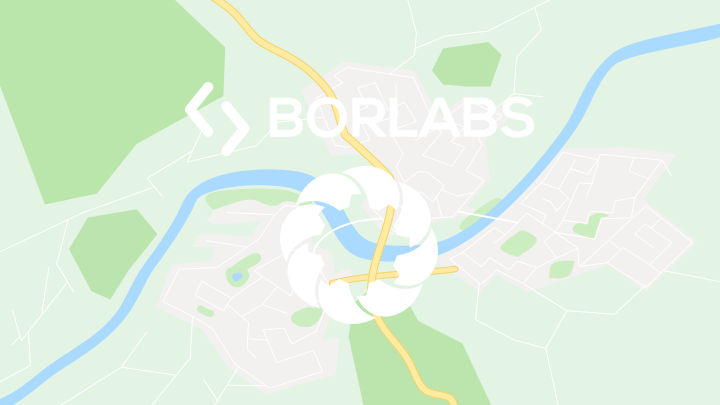
By loading the map, you accept Google’s privacy policy.
Learn more
Load map
1. Plaza de España
Let’s start our tour of Seville with a special highlight, the Plaza de España. For us, this square is probably one of the most beautiful in the entire country. This square, built in 1929 for the Ibero-American Exposition, consists of a semicircular building and a watercourse. There, you’ll find a total of 52 benches decorated with Andalusian tiles.
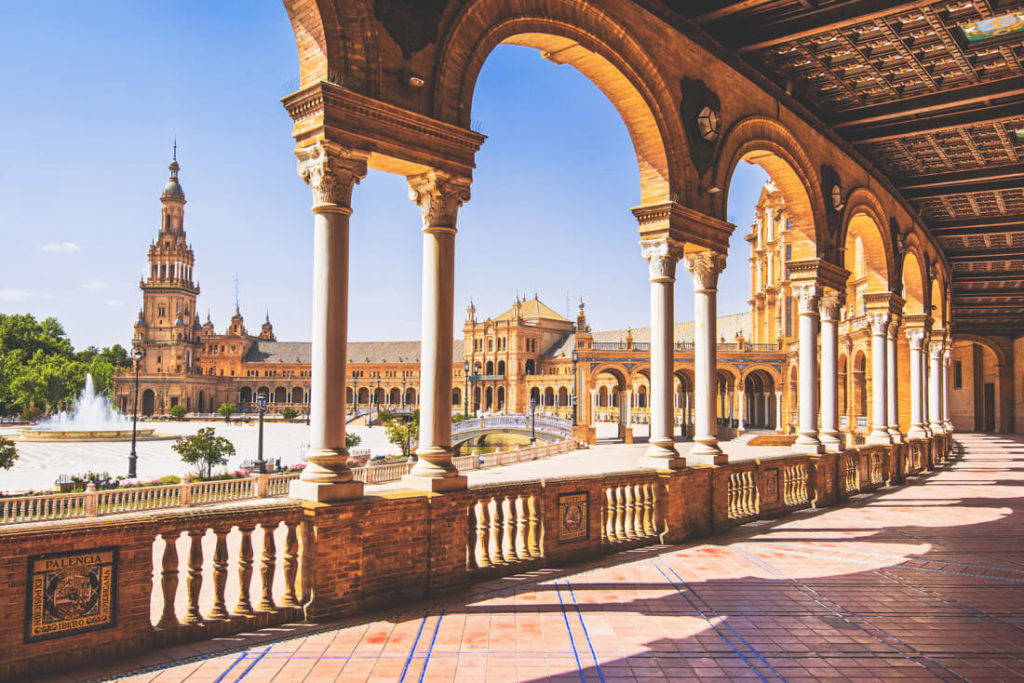
These 52 benches symbolize the Spanish provinces. You can stroll through the alleys or find a shady spot and enjoy the view. In summer, it’s very hot here, like everywhere else in the city. Accordingly, the Plaza de España is quietest in the afternoon. The square is open all day and there’s no admission charge.
2. Metropol Parasol
We hadn’t prepared for our sightseeing tour and stumbled from one highlight to the next. As always, we just went with the flow. At some point, we reached a strange wooden structure located in the middle of the old town. The Metropol Parasol contrasts with the rest of the city, looking more like a futuristic, hypermodern building from the future. It was built in 2011 and is approximately 150 meters long, 70 meters wide, and 26 meters high.
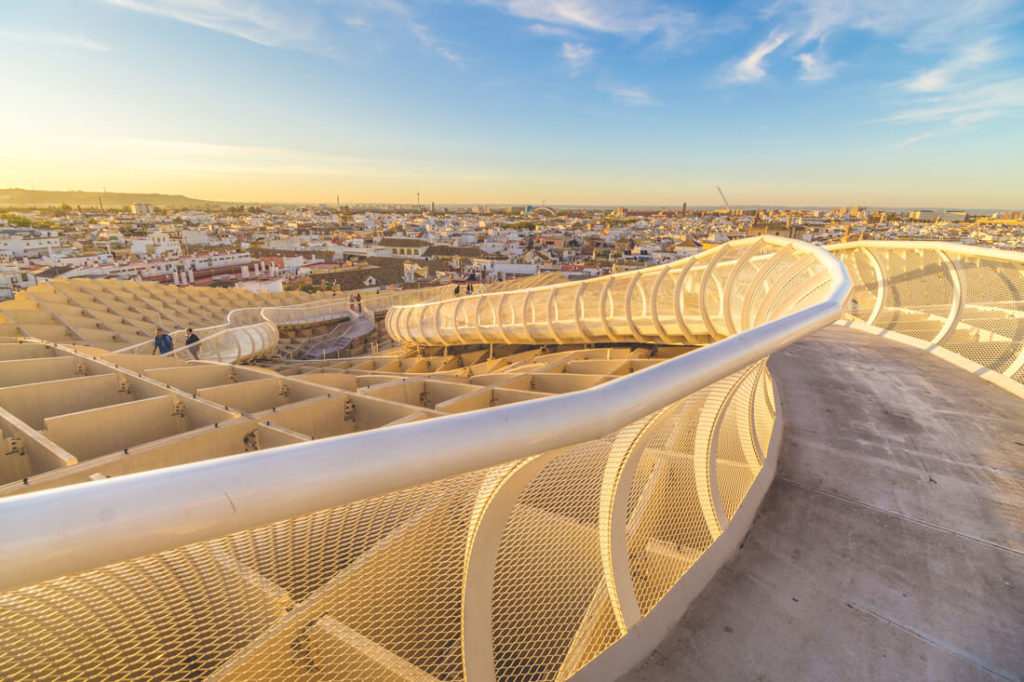
The structure is considered the largest wooden structure in the world and is, so to speak, the city’s modern landmark. Various shops, restaurants, bars, and an archaeological museum await you. Don’t miss the view from the roof. There’s an observation deck with a fantastic view over the rooftops of Seville. The Metropol Parasol is open daily from 10 a.m. to 11 p.m. Admission: €3.
3. Seville Cathedral
What a beautiful building. The cathedral and its Giralda Tower are arguably one of the most important landmarks and sights in Seville. In 1987, the church was declared a UNESCO World Heritage Site. Incidentally, it is the largest Gothic church in the world. Originally, a mosque stood on this site, with the Giralda Tower as its minaret. At some point, however, the Christians recaptured the city and used the building as a church. In the 15th century, everything was finally torn down and the mosque was replaced by a cathedral.

Only the Giralda Tower remains as a bell tower. If you go inside the cathedral, you can marvel at the Royal Chapel. The cathedral also houses the tomb of Christopher Columbus. Entrance costs €10 and allows you to climb to the 17th floor of the bell tower to enjoy the magnificent view of Seville from above. Book a skip-the-line ticket for the cathedral and tower for €18*.
4. Alcazar Seville
The Alcazar resembles a palace from 1001 Nights. Although the Christian prince Peter the Cruel had this palace built, it is immediately apparent that Moors were at work here. The Royal Palace is a beautiful example of the combination of Arabic and Christian architecture. Today, the Alcazar is considered one of the most beautiful buildings of the Mudéjar style. Inside, you will find beautiful ornamentation, high vaulted ceilings, and majestic gardens.
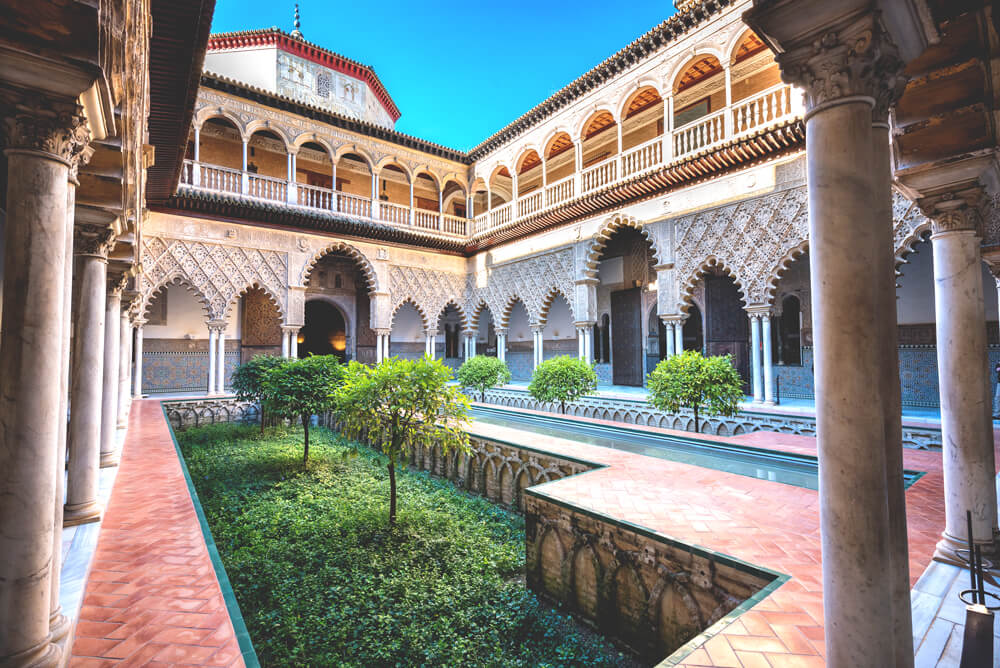
We consider this place a true oasis in the middle of the bustling Spanish city center. The complex is very spacious, and the many tourists are well spread out here. Admission costs €11.50. The palace is open from October to March from 9:30 a.m. to 5 p.m., and from April to September until 7 p.m. You can book tickets here: Guided Tour & Skip the Line*. Or book your combined ticket* for the Alcazar, Cathedral, and Giralda Tower here.
5. Break in Maria Luisa Park
For a short break, a detour to Maria Luisa Park is recommended. This park is located directly across from the beautiful Plaza de España. Especially when the sun is shining, you’ll find lovely shady spots for relaxing and picnicking. The entire complex is in very good condition and was laid out very generously. Numerous buildings and city landmarks are located on the grounds, including the university, the Palace of San Telmo, and the beautiful lotus pond.
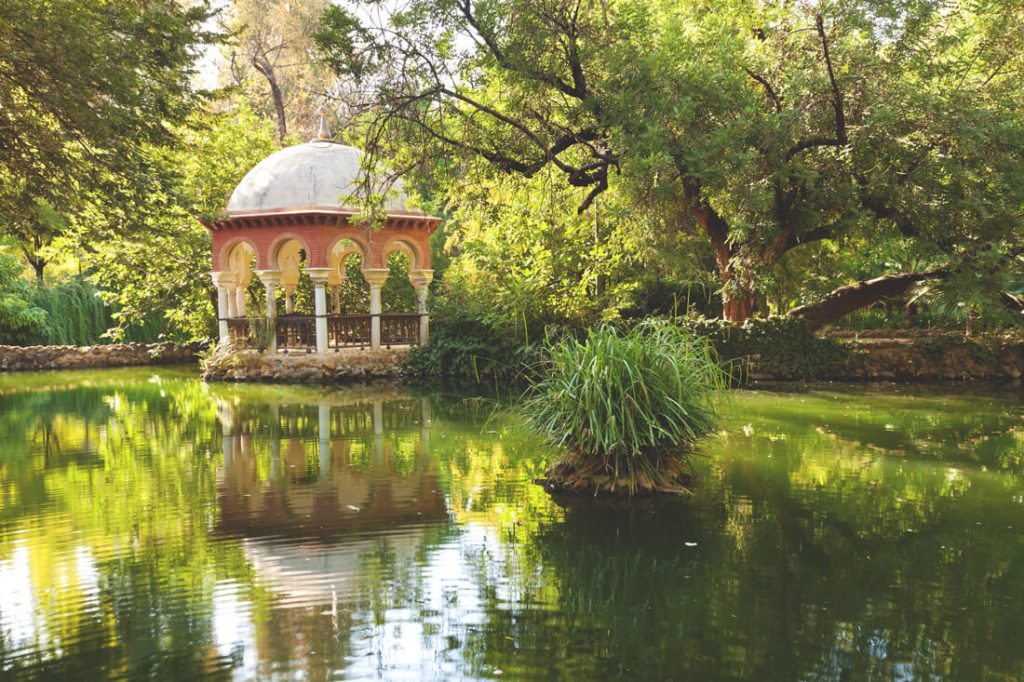
6. The Bullring
If you visit Seville Cathedral, you can also take a detour to the bullring, not far from it. This arena is located in the heart of the old town and is considered a prime example of Andalusian and Arabic architecture. Built in the 18th century, it was long one of the most important bullfighting venues in the south of the country.

Unfortunately, bloody competitions still take place, which the Spaniards enjoy and consider a form of art. It is unfortunately part of culture, but in our opinion it should be banned. We absolutely cannot understand what is supposed to be sport, art, or anything else about it. The building itself is nevertheless very beautiful to look at and also houses a museum.
7. The Old Town of Seville
Old towns have a certain cozy and attractive quality. This is also the case in Seville. The old town is definitely one of the city’s most popular attractions. Here you can stroll, shop, and feast to your heart’s content. Just go with the flow and explore this part of the city on foot. We recommend the cafés Torch Coffee Roasters, Almazen Café, Cafe Otto, and Café Mama Inés. On Calle Sierpes and Calle Tetuan, you’ll find major fashion labels and the usual branches of other brands.
These two pedestrian zones offer everything a shopper’s heart desires. On Calle Córdoba, you’ll find many shoe, jewelry, and accessory stores. Incidentally, there’s a daily flea market in the Alameda de Hercules square, where you can buy books, records, and secondhand items. There’s also a flea market every Wednesday and Sunday in the Plaza Duque de la Victoria.
8. The Santa Cruz District
One of the most beautiful districts in the city is located near the Cathedral and Royal Palace. The Jewish Quarter, “Barrio Santa Cruz,” is one of Seville’s most famous districts and is home to many of Seville’s most important sights. Narrow streets, like a labyrinth, lead from north to south and from west to east. The atmosphere here is truly unique. Just let yourself go and take it all in. You can book a one-hour tour of the district for just €15 at GetYourGuide*.

9. Along the Rio Guadalquivir
The Rio Guadalquivir runs right through the city, separating it from the Triana district. The Puente de Isabel II Bridge is also located here, which was built in 1845 to connect Seville’s old town with the Triana district. From the bridge, you can take wonderful photos and enjoy the view.
The river is especially beautiful in the evening, when the sun slowly disappears behind the horizon. Another really cool thing is that you can take a boat trip here. We can’t say whether it’s really worth it. We only saw the boats in the river. If you try a tour like this, please let us know how it was. You can book a boat trip here for €18*.
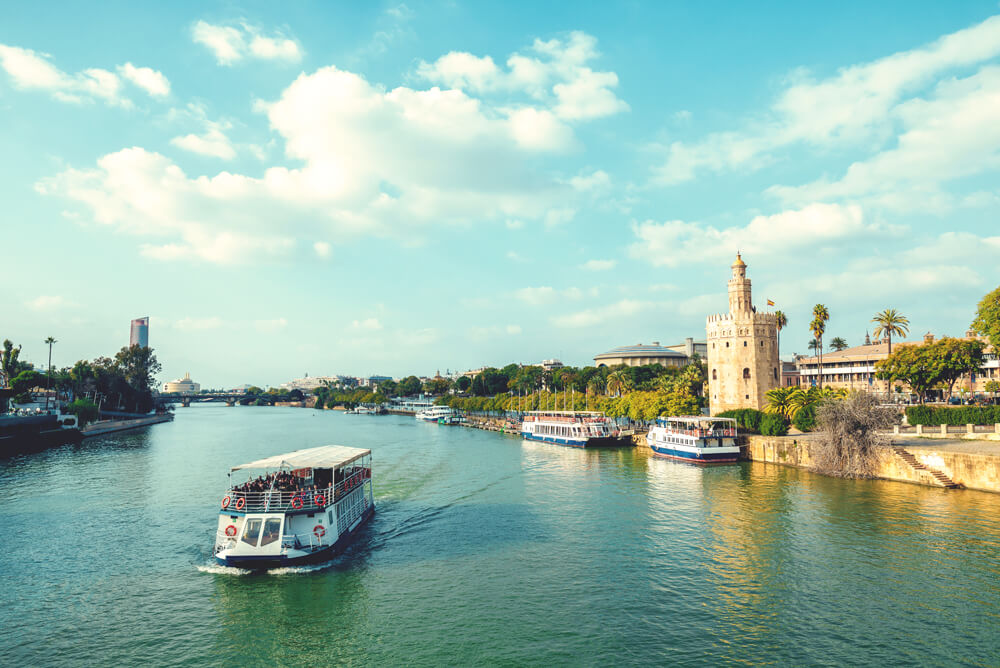
10. The Original Triana
If you want to get to know the original Seville, you should take a detour to the Triana district. Here, among the 50,000 inhabitants, you can experience the southern Spanish flair to the fullest. The colorful tiles, the azulejos, are particularly beautiful and adorn many of Triana’s facades, some of which serve as large-scale murals. The district is also famous for its nightlife.
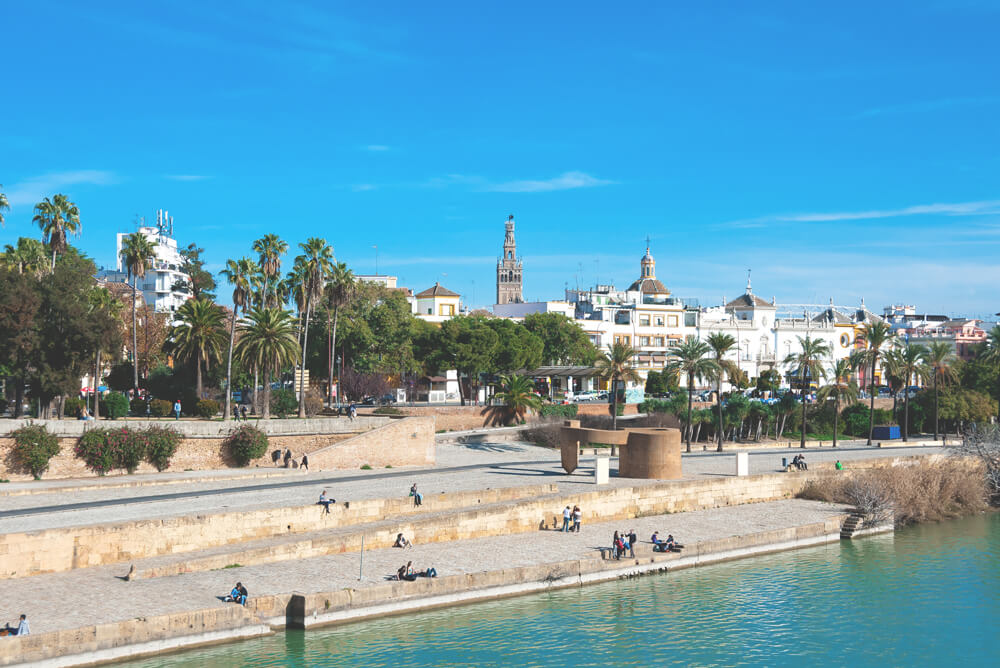
If you like to dance, this is the place for you. The meeting point is Calle Betis, which really comes alive after 10 p.m. Even today, the most beautiful flamenco shows take place here. From Triana, you can also reach many of Seville’s attractions, such as the Cathedral, the Torro del Oro, the Puente de Isabel II Bridge, the market hall, and much more.
11. The Torre del Oro
The Torre del Oro is a defensive tower located on the left bank of the Rio Guadalquivir, right next to the bullring. This tower is approximately 36 meters high and once served as part of the fortress wall. You can visit the defensive tower and enjoy the beautiful view of the river for just €3. There is a museum inside. The tower is open Monday to Friday from 9:30 a.m. to 7 p.m. On weekends, it opens at 10:00 a.m.
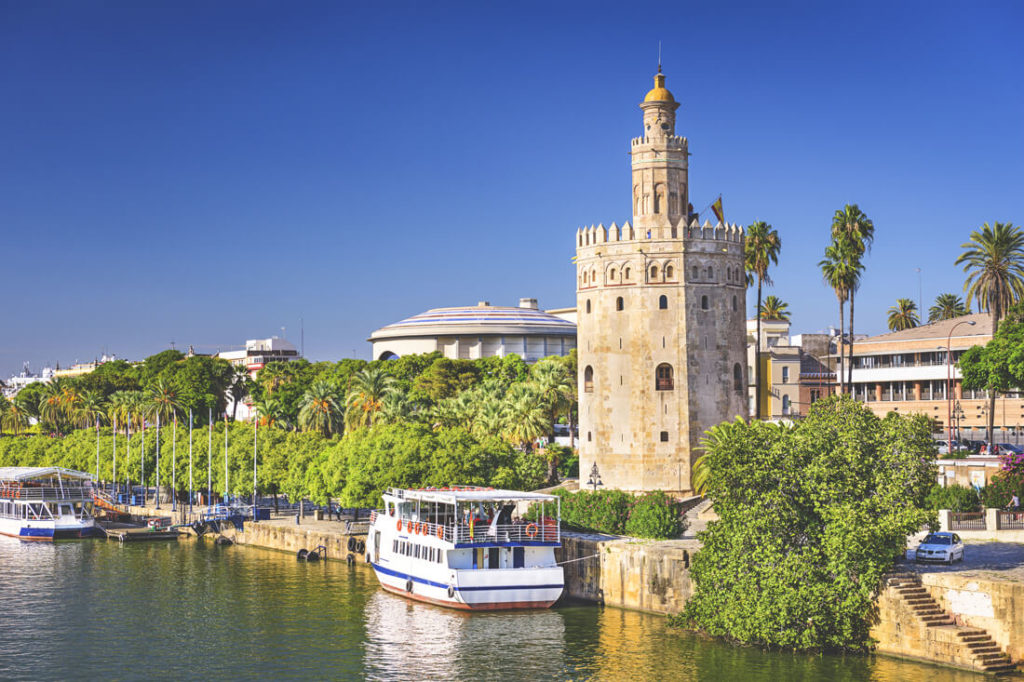
12. Archivo General de Indias
Another attraction in Seville is the Archivo General de Indias. The central archive, both as a building and as the archives of the Spanish state, was declared a UNESCO World Heritage Site in 1987. It houses documents from the Spanish colonial period. The stone building is approximately 56 meters long with a central courtyard and two vaulted floors. You can visit this monument from Tuesday to Saturday between 9:30 a.m. and 4:45 p.m. On Sundays and public holidays, the archive is only open from 10:00 a.m. to 1:45 p.m. Admission is free.

13. The Casa de Pilatos City Palace
The Casa de Pilatos City Palace is also very beautiful. Here you can see the beautiful mix of Gothic, Renaissance, and Arabic culture. The walls are decorated with colorful azulejos (tiles), and the niches contain busts of Roman emperors. The focal point is the pretty dolphin fountain. This building now houses a museum exhibiting Roman sculptures. A magnificent staircase leads you to the upper floor, where you can view various works of art. During peak season, the palace is open from 9 a.m. to 7 p.m., and only until 6 p.m. during off-season. Admission costs €8.
14. Plaza del Cabildo
Not far from the beautiful Seville Cathedral is the Plaza del Cabildo. This square, with its semicircular building, truly beautiful courtyard, ornate facade, and fountain, is a small oasis in the heart of Seville’s old town. Plan a quick visit if you’re already visiting the cathedral. There’s no admission charge, and you can visit this square daily between 10 a.m. and 8 p.m.
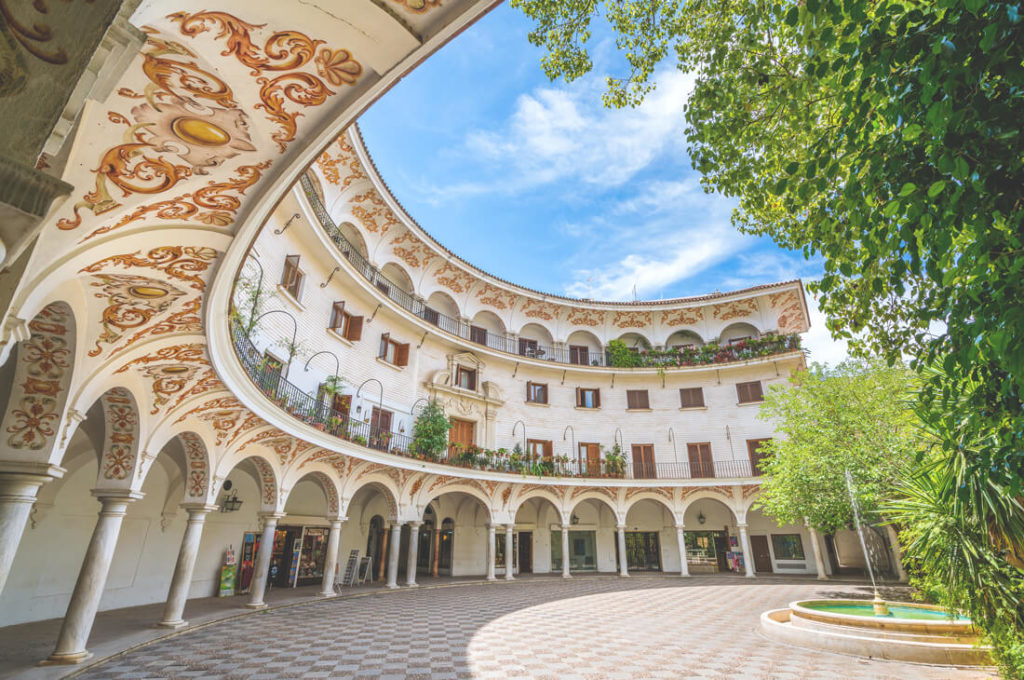
15. Amillo Park in Seville
Haven’t had enough of Seville’s sights yet? We have one more. If you’re looking for a quiet place to take a break, you can visit Amillo Park. It’s located not far from the “Isla Magica” theme park. The many well-kept green spaces invite you to relax, have a picnic, or take a stroll.
The Best Tours & Excursions
You can book a variety of tours and excursions in Seville. So you don’t have to do your own research, we’ve selected the most popular offers for you. As always, you can book these tours through GetYourGuide. We’ve also booked a few tours there and were always very satisfied.
- Seville: Guided Tour of the Alcázar, the Cathedral & Giralda*
- Attend a Flamenco Show in Seville*
- Sunset Bike Tour through the City*
- Seville Game of Thrones Tour*
- Kayaking Tour on the Guadalquivir River*
- Market Tour and Cooking Class*
Getting to Seville
Are you in the mood for Seville? Then start planning your trip now. The fastest way to get to Andalusia from Germany is by plane. From Germany, you can fly from Berlin, Karlsruhe, Hamburg, Memmingen, Frankfurt, and Cologne. In most cases, the low-cost airline Ryanair departs from there. But you can also fly with Lufthansa from Frankfurt, Munich, and Berlin. Round-trip flights generally start at €40. Lufthansa flights are, of course, more expensive.
The airport is about 10 kilometers outside of Seville and is located directly on the A-4. From here, you can take a taxi or bus to the city center. The bus takes about 35 minutes and costs €6 for a round-trip. From Seville, you can also take Alsa buses to other cities. We traveled to Malaga very cheaply. Alternatively, you can also take the AVE high-speed train from Seville to Madrid in 2.5 hours. Regional trains take you from Seville to all other cities in Andalusia.
Best time to travel to Seville
Seville is an attractive travel destination year-round. The best time to travel to Seville is from February to December. During this time, you can expect very good weather conditions. It is warmest in July and August. If you don’t tolerate extreme heat well, you should avoid these months. During these months, temperatures often climb to 40°C. The coolest months are January and February, and December is the rainiest. We recommend the off-season in spring, early summer, and autumn (March, April, May, June, September, October, November).
Booking accommodations
In Seville, you will find numerous beautiful accommodations. We have selected a few affordable and beautiful accommodations in the city center for you. As always, you can of course book whatever you want. We usually book our accommodations through Booking.com or Airbnb. We’ve been very happy with both platforms for years. If you don’t have an Airbnb account yet, you can create one using our invitation link. This will give you €25 discount on your first booking.
- Cathedral House Sevilla*
- Le Petit Paris*
- The Nomad Hostel*
- Hotel Plaza Santa Lucia*
- Hotel Doña Blanca*
- Santiago 15 Hotel Casa Palacio*
Travel reading for Seville
Are you still looking for suitable travel reading? How about the comprehensive Dumont travel guide*? Here you can find out everything about Andalusia on over 440 pages. We love this publisher’s travel guides because they’re well-structured and make you want to visit the destination as you read them. You’ll also find a selection of great travel novels in our shop.